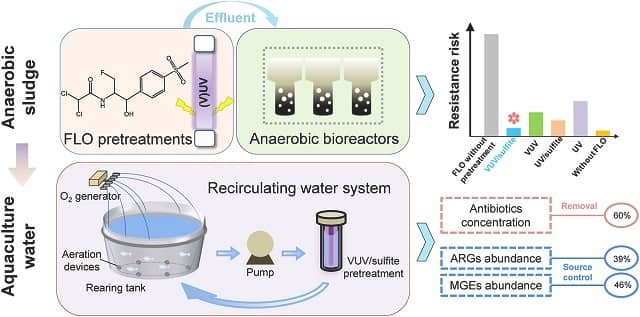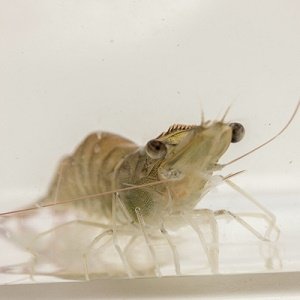
Excessive dependence on antibiotics in the aquaculture industry to combat diseases and promote growth has led to their widespread presence in aquatic environments. This contamination poses a serious threat to human health, as antibiotic-resistant bacteria can spread to humans through contaminated food or water.
To address this issue, effective strategies are urgently needed to reduce antibiotic contamination and mitigate resistance. A study published by scientists from Zhejiang Gongshang University, Zhejiang Zone-King Environmental Sci & Tech Co., Ltd., and Zhejiang Ecological and Environmental Monitoring Center compared the risks of antibiotic resistance in anaerobic sludge fed with wastewater containing florfenicol (FLO) pretreated after four UV or vacuum UV (VUV) driven pretreatments ((V)UV), and established a VUV/sulfite water recirculation system to validate its effect in controlling the risk of antibiotic resistance in real aquaculture water.
The Emergence of a Threat
Antibiotics are essential tools for maintaining fish health in aquaculture. However, their overuse can lead to the emergence of antibiotic-resistant bacteria. These resistant bacteria pose a major threat to human and animal health, making it crucial to find alternative approaches to disease management.
The Challenge of Existing Solutions
While several technologies exist to break down antibiotics in wastewater, they often overlook the potential of persistent antibiotic resistance genes (ARGs) and mobile genetic elements (MGEs). These genetic elements allow bacteria to share their resistance with others, amplifying the problem.
The Role of VUV/Sulfite Treatment
To address this pressing issue, researchers have explored various wastewater treatment technologies in the aquaculture industry. Among them, vacuum ultraviolet (VUV) light combined with sulfite has emerged as a promising solution. VUV-driven photodegradation effectively breaks down antibiotic molecules, while sulfite acts as a reducing agent, enhancing the degradation process.
A New Promising Approach
This study investigated the efficacy of a VUV/sulfite pretreatment system to reduce the risk of antibiotic resistance in aquaculture water. VUV (vacuum ultraviolet) technology uses high-energy light to degrade antibiotics and other contaminants.
Study Results
Researchers compared the impact of different VUV-driven pretreatments on anaerobic sludge fed with wastewater containing florfenicol (florfenicol is a common antibiotic in aquaculture). Their findings demonstrated that the VUV/sulfite combination achieved the most significant reduction in ARGs.
Key Findings
- Effective antibiotic degradation: VUV/sulfite pretreatment showed high efficiency in degrading florfenicol (FLO), a commonly used antibiotic in aquaculture.
- Reduction of ARG abundance: The study observed a significant reduction in ARG abundance in anaerobic sludge treated with wastewater pretreated with VUV/sulfite.
- Controlled bacterial community: VUV/sulfite pretreatment helped maintain a balanced bacterial community, minimizing the risk of horizontal gene transfer (HGT) and the spread of ARGs.
- Successful application in aquaculture systems: The VUV/sulfite system was successfully implemented in a recirculating aquaculture water system, demonstrating its potential for practical application in real-world environments.
Benefits for the Aquaculture Industry
This research offers hope for the aquaculture industry. By implementing VUV/sulfite pretreatment, producers can:
Stay Always Informed
Join our communities to instantly receive the most important news, reports, and analysis from the aquaculture industry.
- Minimize the risk of antibiotic resistance on their farms.
- Promote sustainable and responsible aquaculture practices.
- Contribute to the overall health of the aquatic environment.
Conclusions
The findings of this study highlight the importance of innovative approaches to mitigate antibiotic resistance in aquaculture. VUV/sulfite pretreatment offers a promising solution by effectively degrading antibiotics and reducing the risk of ARG proliferation.
The study’s main results are summarized as follows:
- VUV/sulfite pretreatment significantly reduces the abundance of antibiotic resistance genes (ARGs) in wastewater.
- This reduction in ARGs suggests a lower risk of the spread of antibiotic resistance in aquaculture systems.
- Targeting the source of resistance (the antibiotics themselves) plays a crucial role in controlling the risk.
Further research is needed to explore the large-scale implementation of VUV/sulfite technology in aquaculture. However, this study provides a promising pathway to mitigate the threat of antibiotic resistance in the industry.
The study was funded by the National Natural Science Foundation of China, the “Leading Goose” R&D Program of Zhejiang, and the Zhejiang Provincial Ten Thousand Plan.
Contact
Yangcheng Ding
Sino-Spain Joint Laboratory for Agricultural Environment Emerging Contaminants of Zhejiang Province, College of Environmental and Resources Sciences, Zhejiang Agriculture and Forestry University
Hangzhou 311300, PR China
Email: 20230245@zafu.edu.cn
Reference
Dong, S., Feng, H., Du, Y., Zhou, J., Xu, J., Lin, D., Ding, D., Xia, Y., Wang, M., & Ding, Y. (2024). Source elimination of antibiotic resistance risk in aquaculture water by VUV/sulfite pretreatment. Journal of Environmental Management, 370, 122644. https://doi.org/10.1016/j.jenvman.2024.122644
Editor at the digital magazine AquaHoy. He holds a degree in Aquaculture Biology from the National University of Santa (UNS) and a Master’s degree in Science and Innovation Management from the Polytechnic University of Valencia, with postgraduate diplomas in Business Innovation and Innovation Management. He possesses extensive experience in the aquaculture and fisheries sector, having led the Fisheries Innovation Unit of the National Program for Innovation in Fisheries and Aquaculture (PNIPA). He has served as a senior consultant in technology watch, an innovation project formulator and advisor, and a lecturer at UNS. He is a member of the Peruvian College of Biologists and was recognized by the World Aquaculture Society (WAS) in 2016 for his contribution to aquaculture.




